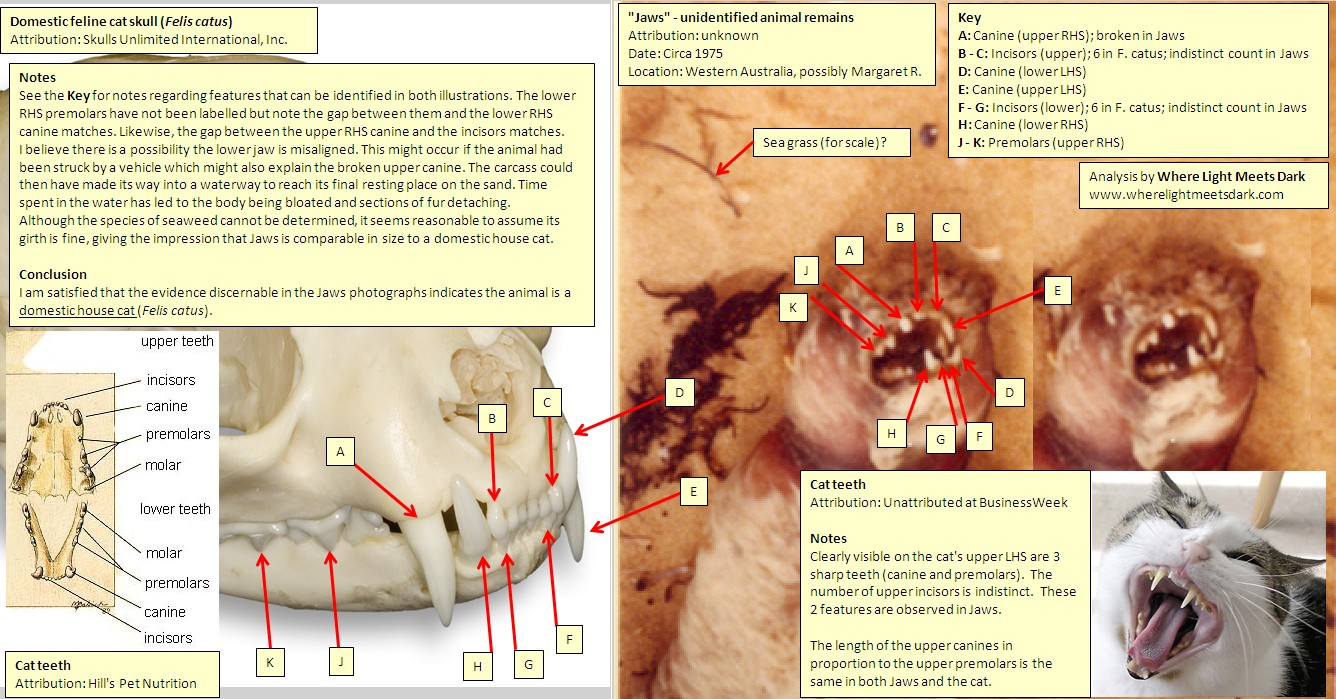West thylacoleo - Jaws
Overview
Some time ago (some sources say 1975, others 1995, others 1999), someone took a photograph of a decaying mammal on a beach in Western Australia. The name Sharon West is associated with the photo although it is not clear if West took the photograph or is simply now in possession of it.
In any case, the photo shows an animal lying on its back, one forepaw draped across its body, with its mouth open. Teeth are clearly visible and have fueled much debate over what the creature is. Some theorise that this is an example of Thylacoleo carnifex - otherwise presumed extinct for 20,000 to 30,000 years.
Darren Naish has written an interesting article at the science blog website Tetrapod Zoology which has attracted a large number of comments.
Naish reports the photo as being taken circa 1975 in the Margaret River area. He also notes that Karl Shuker's 1996 book The Unexplained contained a cropped version.
Naish writes "Its teeth show us that it's evidently not a modern-day thylacoleonid, alas (because thylacoleonids have highly distinctive, protruding incisors and gigantic carnassials), but what is it? There's some real weirdness going on here: let me know what you think, and I'll add my own thoughts later."
And so we come to the question - what is it?
An analysis of the teeth
(Click to enlarge)
I first analysed this photo in April 2008, concluding from its teeth that this was a domestic cat. Today I put all the details together in a single image file which can be seen in full by clicking on the illustration shown here.
The logic is included in the image and reproduced below...
Attributions
The domestic cat skull (Felis catus) is attributed to Skulls Unlimited International, Inc. The Jaws photo attribution is unknown. The cat teeth illustration is attributed to Hill's Pet Nutrition. The photo of a yawning cat is unattributed at BusinessWeek.
The various teeth in both photos are labelled as follows:
Key
A: Canine (upper RHS); broken in Jaws
B - C: Incisors (upper); 6 in F. catus; indistinct count in Jaws
D: Canine (lower LHS)
E: Canine (upper LHS)
F - G: Incisors (lower); 6 in F. catus; indistinct count in Jaws
H: Canine (lower RHS)
J - K: Premolars (upper RHS)
Notes in comparing the cat skull to Jaws
See the Key for notes regarding features that can be identified in both illustrations. The lower RHS premolars have not been labelled but note the gap between them and the lower RHS canine matches. Likewise, the gap between the upper RHS canine and the incisors matches.
I believe there is a possibility the lower jaw is misaligned. This might occur if the animal had been struck by a vehicle which might also explain the broken upper canine. The carcass could then have made its way into a waterway to reach its final resting place on the sand. Time spent in the water has led to the body being bloated and sections of fur detaching.
Although the species of seaweed cannot be determined, it seems reasonable to assume its girth is fine, giving the impression that Jaws is comparable in size to a domestic house cat.
Notes in comparing the yawning cat to Jaws
Clearly visible on the cat's upper LHS are 3 sharp teeth (canine and premolars). The number of upper incisors is indistinct. These 2 features are observed in Jaws.
The length of the upper canines in proportion to the upper premolars is the same in both Jaws and the cat.
Conclusion
I am satisfied that the evidence discernable in the Jaws photographs indicates the animal is a domestic house cat (Felis catus).
An analysis of the Jaws photo by Jeff Johnson is also available at Debbie's Quest for Thylacoleo website.

